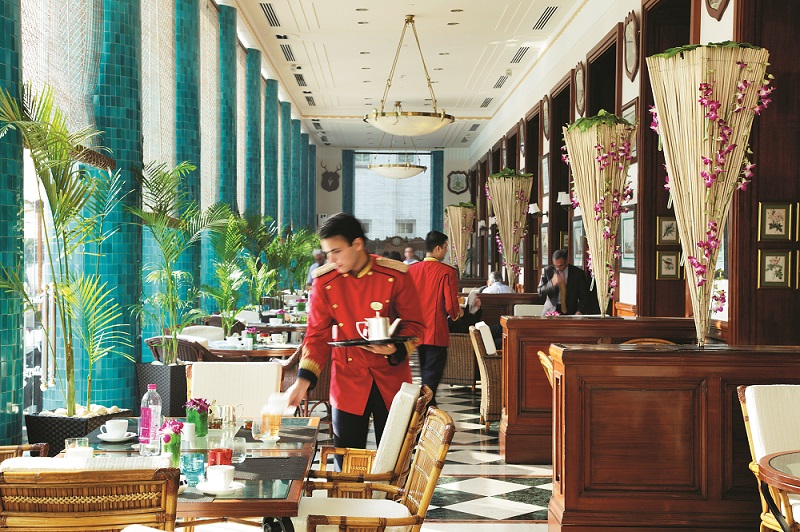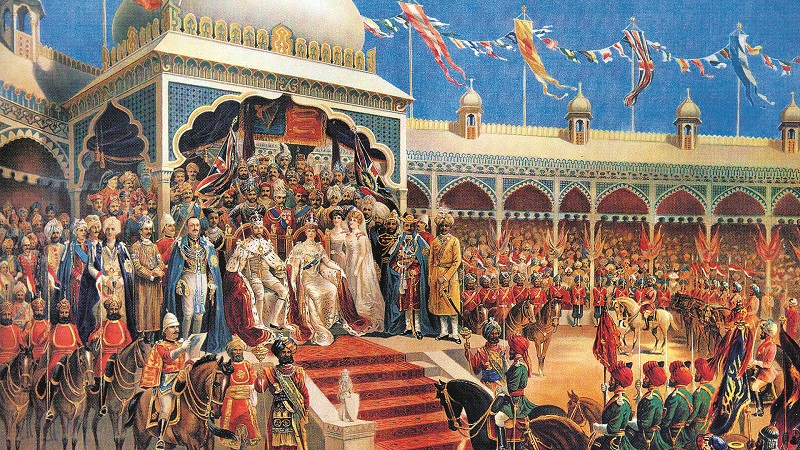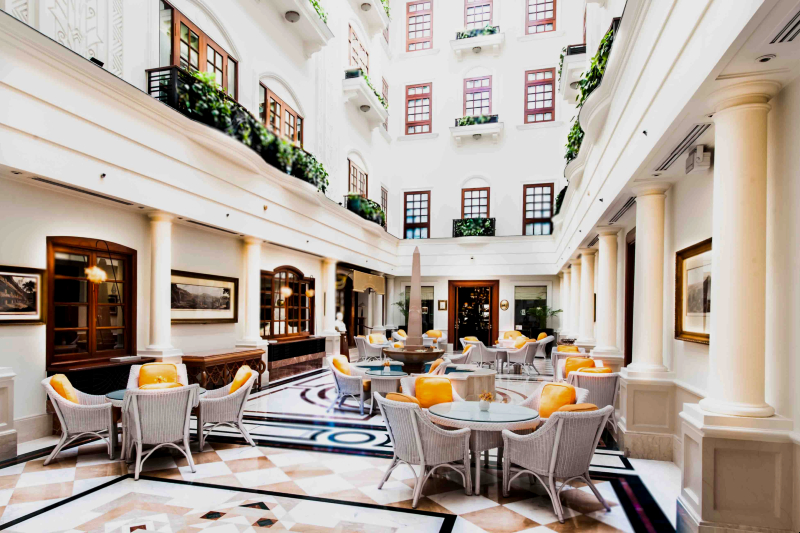
The Spice Route restaurant is designed by Rajeev Sethi and features hand-painted murals by artists from a temple in Guruvayur, Kerala (All photos: The Imperial New Delhi)
The Imperial Hotel may be situated in the middle of bustling Janpath — within the tourist heart of New Delhi — but it feels like a portal into an older, slower time. Step out of the long driveway and there will be the usual cacophony of Indian street sounds: autorickshaws soliciting passengers; a pair of stray dogs barking at honking traffic; Tibetan shops filled with sounds of bargaining in many languages. But step inside the walls of The Imperial, a historic luxury hotel that opened its doors in 1936 on the road called Queensway in British India, and you are transported through time to New Delhi’s first grand hotel, inaugurated by Lord Willingdon, then viceroy of India.
The building still faces a vision of undulating green lawns. Red-turbaned guards in cummerbunds hold open the doors, reminiscent of the grand old hotels of the East such as The Strand in Rangoon or The Raffles in Singapore. There are wide Italian-marble hallways with chequered floors and high ceilings, glistening silver tea service, tableware from London, Belgian chandeliers, Myanmar teak furniture and a priceless art collection.
The collection includes the works of artists in India in the late 17th and early 18th centuries who produced etchings, wood engravings, lithographs, aquatints and mezzotints based on sketches of landscapes, architecture and topography of British India. The Imperial hosted an art exhibition as early as 1936, inaugurated by the Maharaja of Patiala, and has continued to curate a collection of detailed works on Moghul monuments and imposing forts, historical events, naval and military scenes, royal durbars, costumes, castes and trades of India, and an abundance of natural beauty in majestic mountains and magnificent waterfalls.
1911_verandah_lounge.jpg

That this hotel is sometimes called the Museum Hotel comes as no surprise. Wandering the hallways, one feels the ghosts of dead Englishmen immortalising a dying empire through art, displaying the last images of colonial might through memorabilia from all around a region rapidly shrugging off the yoke of the British Raj. India attained independence in 1947, a mere 11 years after the opening of this hotel, and the walls echo the last gasp of an imperial way of life, a life that was fast disappearing even as the blueprint of Indian independence was being discussed in the ballroom of this building.
It was at The Imperial that leading political figures such as Lord Mountbatten, Mahatma Gandhi, Jawaharlal Nehru and Muhammad Ali Jinnah often met to discuss the future of India in an informal and congenial setting.
1911 was a landmark year in the history of New Delhi, as it was then that King Emperor George V declared New Delhi the capital of India, shifting the seat of power from Calcutta. The entrance to the 1911 Restaurant in the hotel pays tribute to this historic milestone with a towering picture of King Emperor George V and Queen Empress Mary enthroned within the Red Fort, surrounded by cavalry and courtiers in a vivid display of imperial wealth.
the-imperial-coronation-ceremony-displayed-at-1911-restaurant.jpg

Magnificent views of the Delhi Durbar are also on display on the many larger-than-life scenes of elephant howdahs carrying British officials, wending their way past the Mughal forts of ancient Delhi. The staircase leading to the plush ballroom overlooking gardens and pillared verandahs feature rare art and lithographs, and some of the prominent artists displayed are Thomas and William Daniells, William Simpson, William Hodges, John Zollony, Anne Eliza Scott, James Ferguson, J B Fraser and Emily Eden.
There are three main art galleries, and the collection of life-size oil paintings of the Princely Rulers of India outside the ballroom is especially striking. The Royal Ballroom also boasts a huge 11ft by 22ft oil painting by Bourne and Shepard, titled The Durbar of the Nawab of Maler Kotla, which vividly brings to life the opulence of courtly existence of the early 1900s. The ballroom was the site of meetings to discuss the Partition of India, and the stairway is lined with portraits of famous Indian politicians of the time.
The hotel has carefully preserved its collection of original engravings and lithographs and added to it over time. Each floor is dedicated to an artist whose original works adorn the walls of the rooms and the corridors, and care has been taken to recreate the ambience of the Raj. Scenes from Lucknow, Calcutta, Agra, Madras, Bombay and Delhi bloom to life at every turn.
the-atrium-tea-lounge-with-natural-light.jpg

The Imperial also has the largest collection on display of war gallantry awards in India and neighbouring countries such as Afghanistan, Myanmar, Bhutan and China. The bar — the Patiala Peg — where Nehru, Gandhi, Jinnah and Mountbatten once met, not only still serves popular cocktails such as the signature Chak de Phatte made with eight kinds of spirits, but also houses a Victoria Cross, the highest gallantry award in the British Army.
The intricate murals and carved woodwork of The Spice Route — a restaurant that serves food from around Asia — tell an intriguing story of the spice trade and the intermingling of foods and cultures. This establishment serves an excellent Malaysian mee goreng, as well as chicken rendang.
The Imperial’s pillared verandahs, tea lounges, ballroom and sprawling gardens continue to be popular social spaces for Indian and foreign politicians, business people and luminaries. If you close your eyes and listen closely, the walls of the hotel still resound with the tinkle of muted piano keys and the swish of silks twirling in a waltz. In this age of high-rises constructed of chrome and glass, it is wonderful to step into a place still so committed to preserving history, still so undiminished by time.
This article first appeared on Jan 11, 2021 in The Edge Malaysia.


